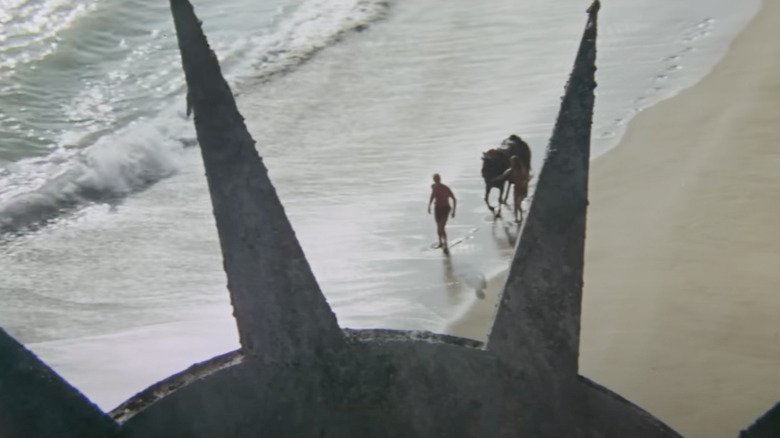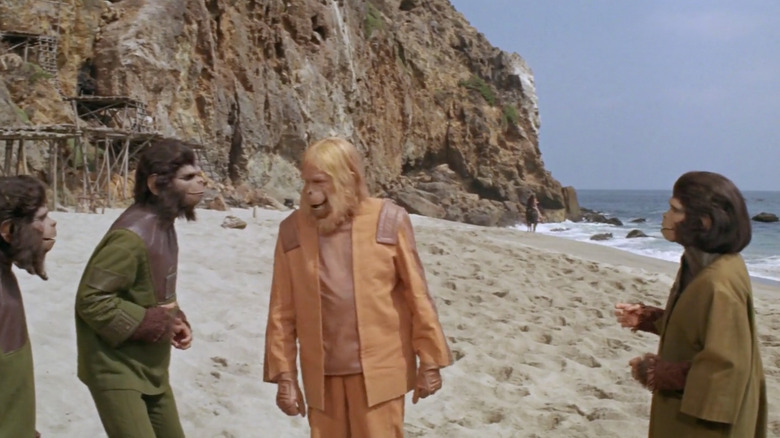One Of The Greatest Movie Plot Twists Of All Time Was Shot In Malibu's Point Dume
What does the end of the world look like? It's a question that's been asked by many a genre filmmaker, especially as the post-apocalyptic (and just plain apocalyptic) film rose in popularity following the invention of nuclear weaponry. For most filmmakers, the setting for the apocalypse tends to fall into one of two categories: It's either a sprawling urban ruin, with once-gleaming skyscrapers now in disarray, or a vast desert landscape where the detritus of the old world is scattered throughout miles of sand and rock. Very few films depicting the end of the world decide to make the apocalypse look like an idyllic ocean view vacation.
Yet, that's precisely what 1968's "Planet of the Apes" did, as the production chose to stage its climactic twist on and around Malibu's Point Dume. Sitting on the outskirts of Los Angeles in Southern California, the combination of beach and a prominent rock cliff makes Point Dume look and feel like a place outside of time, a quality that extends to the area's name itself. According to a promotional piece for the nearby Malibu Beach Inn, Point Dume was intended to be named after Padre Francisco Dumetz, with the last name being pronounced "DUM-MAY." However, someone misinterpreted the spelling based on the pronunciation, and "Dume" stuck instead.
Throughout cinema history, Point Dume has enjoyed a life pitched somewhere between opulent beauty and eerie ominousness. It's been the setting for everything from a party in "The Big Lebowski" to Tony Stark's mansion in the "Iron Man" films, yet it's also where the surreal 1974 horror movie "Messiah of Evil" was shot, and it's the place where genre legend Vincent Price had his ashes scattered upon his death in 1993. One could argue that the Point's appearance in the conclusion of "Planet of the Apes" helped contribute to this unique legacy. The scene is certainly the most iconic moment ever filmed at the Point, as the shot of a broken Statue of Liberty (apparently constructed from paper maché and cardboard) overlooking the beach while astronaut George Taylor (Charlton Heston) realizes he's been back on Earth the entire time is emblematic of the film, the "Planet of the Apes" movie series, and genre cinema in general. It's a twist that possibly wouldn't have hit as hard were it not for the unique look of Point Dume.
Point Dume contributes to the bait-and-switch twist ending of Planet of the Apes
One of the ingenious aspects that made the ending of "Planet of the Apes" — the revelation that Taylor and his spaceship had inadvertently traveled into Earth's future, in which humans had become mute and subjugated by a race of intellectually advanced apes — an all-timer of a plot twist was that it slyly remixed the Pierre Boulle novel that the film was adapting. In the book, it's revealed up front that its astronauts travel to a completely separate planet ruled by intelligent apes, where humans are a lower species. The novel's twist involved the astronauts returning to Earth and discovering that intelligent apes had begun to rise there, too. It was the choice of screenwriters Michael Wilson and Rod Serling to make the novel's political and social metaphors hit harder for a Cold War-era audience by utilizing a twist that Serling had already workshopped on his series "The Twilight Zone" (specifically, the episode "I Shot an Arrow into the Air").
The trick to the twist would be to not reveal that Taylor was having his adventure within a post-apocalyptic Earth until the very last moment of the film. While this was accomplished by setting the majority of the movie in the desert (locations like Lake Powell and Glen Canyon National Recreation Area were used), the real bait-and-switch was using Point Dume for the climax. The location somewhat resembles the end of the world in literal terms, with the earth, rock, and sand coming right up to a vast, blue ocean. The biggest incongruity comes from the iconic visual of the Statue of Liberty broken (or buried) in the beach, a visual cue to Taylor (who'd left from the then-slightly futuristic year of 1972) of where and when he was. The sight of a fallen Liberty thus became a powerful shorthand for dozens of genre films to follow when looking to evoke the U.S.' downfall on a grand scale: Everything from "Independence Day" to "Cloverfield" and the poster art for "Escape From New York" owes a debt to "Apes."
Similarly, "Planet of the Apes" owes a debt to Point Dume, a location that could seem beautiful one moment and bleak and barren the next. If the final twist in the film had been set in some interior location, or some nondescript exterior, it would still have been intellectually engaging and had some emotional weight. Yet, it wouldn't have had the same impact as seeing Heston on Dume's beach, beating his fists helplessly against the sand. The film certainly helped contribute to Point Dume's popularity as a tourist attraction subsequent to its release, too. Ironically, those filmmaking maniacs, they blew it up.

